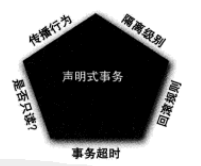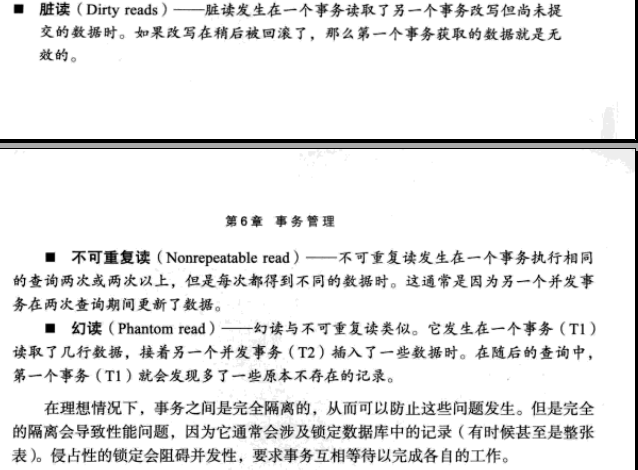Spring Hibernate Transaction示例
JDBCDAO.java

package com.bf; import java.sql.ResultSet; import java.sql.SQLException; import java.util.Date; import org.hibernate.Session; import org.hibernate.SessionFactory; import org.springframework.context.ApplicationContext; import org.springframework.context.support.ClassPathXmlApplicationContext; import org.springframework.jdbc.core.JdbcTemplate; import org.springframework.jdbc.core.RowMapper; import org.springframework.context.ApplicationContext; import org.springframework.context.support.ClassPathXmlApplicationContext; import java.util.List; import java.util.Date; import java.util.Iterator; import org.hibernate.HibernateException; import org.hibernate.Session; import org.hibernate.Transaction; import org.hibernate.SessionFactory; import org.hibernate.cfg.Configuration; public class JDBCDAO implements SpitterDAO { private static String GET_SQL = "select code_item from trans_schedule where ID_NO = ?"; private JdbcTemplate jdbcTemplate; public void setJdbcTemplate(JdbcTemplate jdbcTemplate) { this.jdbcTemplate = jdbcTemplate; } public SpitterObj getSpitter(int ljdm) { return jdbcTemplate.queryForObject(GET_SQL, new RowMapper<SpitterObj>() { public SpitterObj mapRow(ResultSet rs, int rowNum) throws SQLException { SpitterObj obj = new SpitterObj(); obj.setLOT(rs.getString(1)); return obj; } }, ljdm); } private static SessionFactory factory; public JDBCDAO() { } public void setSessionFactory(SessionFactory sessionFactory) { this.factory = sessionFactory; } public void SaveEvent(){ factory.getCurrentSession().persist(new Event( "Our very first event!", new Date())); throw new RuntimeException("asdfsafd"); } }
ApplicationContext.xml

<?xml version="1.0" encoding="UTF-8"?> <beans xmlns="http://www.springframework.org/schema/beans" xmlns:xsi="http://www.w3.org/2001/XMLSchema-instance" xmlns:p="http://www.springframework.org/schema/p" xmlns:aop="http://www.springframework.org/schema/aop" xmlns:tx="http://www.springframework.org/schema/tx" xsi:schemaLocation="http://www.springframework.org/schema/beans http://www.springframework.org/schema/beans/spring-beans-3.0.xsd http://www.springframework.org/schema/aop http://www.springframework.org/schema/aop/spring-aop-3.0.xsd http://www.springframework.org/schema/tx http://www.springframework.org/schema/tx/spring-tx-3.0.xsd"> <bean id="dataSource" class="org.apache.commons.dbcp.BasicDataSource"> <property name="driverClassName" value="oracle.jdbc.driver.OracleDriver" /> <property name="url" value="jdbc:oracle:thin:" /> <property name="username" value="" /> <property name="password" value="" /> </bean> <bean id="jdbcTemplate" class="org.springframework.jdbc.core.JdbcTemplate"> <constructor-arg ref="dataSource" /> </bean> <bean id="dao" class="com.bf.JDBCDAO" autowire="byName"> <property name="jdbcTemplate" ref="jdbcTemplate" /> <property name="sessionFactory" ref="sessionFactory"/> </bean> <bean id="Audience" class="com.bf.Audience" autowire="byName"> </bean> <bean id="sessionFactory" class="org.springframework.orm.hibernate5.LocalSessionFactoryBean"> <property name="dataSource"> <ref bean="dataSource" /> </property> <property name="hibernateProperties"> <props> <prop key="hibernate.dialect"> org.hibernate.dialect.Oracle9Dialect </prop> </props> </property> <property name="mappingResources"> <list> <value>Event.hbm.xml</value> </list> </property> </bean> <bean id="transactionManager" class="org.springframework.orm.hibernate5.HibernateTransactionManager"> <property name="sessionFactory"> <ref bean="sessionFactory" /> </property> </bean> <aop:config> <aop:pointcut id="bizServiceMethod" expression="execution(* com.bf.SpitterDAO.SaveEvent(..))" /> <aop:advisor pointcut-ref="bizServiceMethod" advice-ref="bizAdvice" /> </aop:config> <tx:advice id="bizAdvice" transaction-manager="transactionManager"> <tx:attributes> <tx:method name="Save*" propagation="REQUIRED" rollback-for="Exception" /> </tx:attributes> </tx:advice> </beans>
Spring并不直接管理事务,而是提供了多种事务管理器,它们将事务管理的职责委托给JTA(Java Transaction API)或其它持久化机制所提供的平台相关的事务实现。如上面的HibernateTransactionManager,用于Hibernate进行持久化。
Application.java
package com.bf;
import org.springframework.context.ApplicationContext;
import org.springframework.context.support.ClassPathXmlApplicationContext;
import java.util.List;
import java.util.Date;
import java.util.Iterator;
import org.hibernate.HibernateException;
import org.hibernate.Session;
import org.hibernate.Transaction;
import org.hibernate.SessionFactory;
import org.hibernate.cfg.Configuration;
@SuppressWarnings("unused")
public class Application {
public static void main(String[] args) {
try{
ApplicationContext context = new ClassPathXmlApplicationContext("applicationContext.xml");
SpitterDAO dao = (SpitterDAO)context.getBean("dao");
dao.SaveEvent();
}catch (Throwable ex) {
throw new ExceptionInInitializerError(ex);
}
}
}
事务基本特性 ACID
原子性(Atomic): 事务中所有操作要么全部完成,要么全部不完成。
一致性(Consistent): 一旦事务完成(不管是成功还是失败),系统必须确保它所建模的业务处于一致的状态。现实的数据不应该被损坏。
隔离性(Isolated): 事务允许多个用户对相同的数据进行操作,每个用户的操作不会与其它用户纠缠在一起。因此,事务应该被隔离,避免发生同步读写相同数据的事情。
持久性(Durable): 一旦事务完成,事务的结果应该持久化。
原子性与 隔离性确保了一致性。
声明式事务属性
在Spring中,声明式事务是通过事务属性来定义的。

上面xml中定义的propagation="REQUIRED"表示当前方法必须运行在事务中,其它的值为REQUIRED_NEW等。它定义事务的传播行为。
声明式事务的第二个维度是隔离级别,隔离级别定义了一个事务可能受其它并发事务的影响程度。并发虽然是必须的,但可能会导致如下问题

另一个版本:https://spring.io/guides/gs/managing-transactions/
签名:删除冗余的代码最开心,找不到删除的代码最痛苦!



